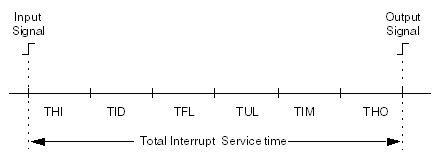|
Basics of Interrupt Processing
|
|
|
(Original Document)
|

|
Time
|
Name
|
Description
|
|---|---|---|
|
THI
|
Hardware Input Latency
|
THI time is defined as the time from the input field connector to the interrupt into theCPU going active.
|
|
TID
|
Interrupt Delay
|
TID time is defined as the time that firmware is unable to service interrupts. This is done because the CPU maybe communicating with other Quantum modules (I/O,NOM, RIO, etc.).
|
|
TFL
|
Firmware Latency
|
TFL time is the time that is required to identify source of the interrupt signal.
|
|
TUL
|
User Logic
|
TUL time is based strictly on the users interrupt program.
|
|
TIM
|
Immediate I/O
|
TIM time is the time from the output command of the interrupt program to the output module.
|
|
THO
|
Hardware Output Latency
|
THO time is based on the time from the output of the ASIC to the field connector.
|
|
Operation
|
TID (worst case)
|
|---|---|
|
Hot swapping an option module
|
208 μs
|
|
Simple module with 4 byte rd/wr transfer*
|
148 μs
|
|
DPM module with 6 byte transfer**
|
171 μs
|
|
User logic editing/power flow display
|
3-100 μs
|
|
Modbus communication
|
243 μs
|
|
CPU Modbus Plus communication
|
180 μs
|
|
NOM communication with Modbus message
|
208 μs
|
|
NOM-like modules***
|
208 μs
|
|
*
|
140DDI35300, 140DDO35300, 140DAI54300, 140DAO84210, 140DRC83000, 140HLI34000
|
|
**
|
140ACO02000, 140ACI03000, 140AVI03000, 140AVO02000
|
|
***
|
140CHS11000, 140CRA21X00, 140MMS4250X, 140NOA61100, 140NOE2X100
|